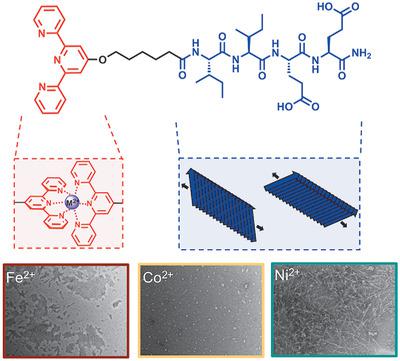当前位置:
X-MOL 学术
›
Macromol. Rapid Commun.
›
论文详情
Our official English website, www.x-mol.net, welcomes your
feedback! (Note: you will need to create a separate account there.)
Kinetic Evolution in Metal-Dependent Self-Assembly of Peptide-Terpyridine Conjugates.
Macromolecular Rapid Communications ( IF 4.2 ) Pub Date : 2019-12-27 , DOI: 10.1002/marc.201900565 Jugal Kishore Sahoo 1 , Michael A VandenBerg 1 , Matthew J Webber 1
Macromolecular Rapid Communications ( IF 4.2 ) Pub Date : 2019-12-27 , DOI: 10.1002/marc.201900565 Jugal Kishore Sahoo 1 , Michael A VandenBerg 1 , Matthew J Webber 1
Affiliation

|
Nature realizes impressive structures and emergent functions through precisely organized non-covalent interactions, and this inspires the use of supramolecular motifs to engineer new materials. Herein, an amphiphilic peptide-terpyridine conjugate is reported that forms 1D nanostructures leading to hydrogels. Upon the addition of metal, a slow kinetic transition occurs, resulting in nanostructures which are dictated by the chosen metal binding to the terpyridine ligand. As such, bis-complex formation between terminal terpyridines redirects the assembly from peptide-driven 1D structures to an assortment of new nanostructures which evolve and appear over the course of weeks. Studies where pre-existing peptide structures are disrupted prior to metal addition yield these same structures right away, further confirming the kinetically labored pathway to their formation when beginning from an assembled state.
中文翻译:

肽-Terpyridine共轭物的金属依赖性自组装的动力学演化。
大自然通过精确组织的非共价相互作用实现了令人印象深刻的结构和新兴功能,这激发了超分子基序的使用来设计新材料。在此,报道了形成一维纳米结构导致水凝胶的两亲性肽-吡啶吡啶共轭物。在添加金属时,发生缓慢的动力学转变,从而导致纳米结构,该纳米结构由所选择的金属与三联吡啶配体的结合决定。因此,末端吡啶之间的双复合物形成将组装体从肽驱动的1D结构重定向到一系列新的纳米结构,这些结构在数周的时间内演化并出现。在添加金属之前先破坏已有的肽结构的研究马上就产生了这些相同的结构,
更新日期:2019-12-27
中文翻译:

肽-Terpyridine共轭物的金属依赖性自组装的动力学演化。
大自然通过精确组织的非共价相互作用实现了令人印象深刻的结构和新兴功能,这激发了超分子基序的使用来设计新材料。在此,报道了形成一维纳米结构导致水凝胶的两亲性肽-吡啶吡啶共轭物。在添加金属时,发生缓慢的动力学转变,从而导致纳米结构,该纳米结构由所选择的金属与三联吡啶配体的结合决定。因此,末端吡啶之间的双复合物形成将组装体从肽驱动的1D结构重定向到一系列新的纳米结构,这些结构在数周的时间内演化并出现。在添加金属之前先破坏已有的肽结构的研究马上就产生了这些相同的结构,











































 京公网安备 11010802027423号
京公网安备 11010802027423号